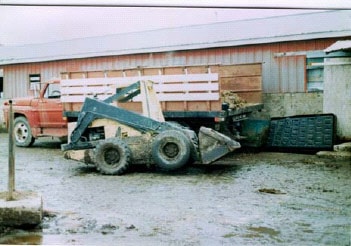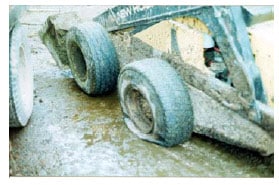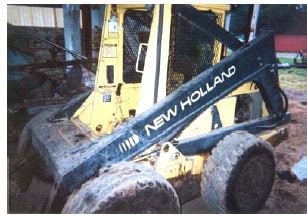Farmer Crushed Between Lift Arms and Frame of Skid-steer Loader
Investigation: # 01MI029
SUMMARY
 |
| Figure 1 |
On May 27, 2001, a 67-year old male farmer died from injuries sustained when he was crushed between the lift arm and the window frame of a skid-steer loader. The skid-steer loader was being used to pick up the manure cleaned from stalls. The witness to this incident worked inside the building scraping manure from stalls to a bay door. The victim had been clearing the piles of manure away from the bay door and loading the manure into a stake truck for about an hour. The truck was located on a concrete pad near the barn. The side safety screens on the skid-steer loader had been damaged during a fire and had not been replaced. Three tires on the loader were conventional truck tires; a skid-steer tire was located on the right rear of the loader. Foot pedals controlling the operation of the loader arms and bucket were located on the floor near the front frame of the loader. The left foot pedal raised and lowered the skid-steer loader arms, and the right foot pedal controlled bucket tilt. While the victim was loading the manure, the left rear truck tire failed. The victim leaned his head outside of the operator’s compartment through the unguarded window opening to look at the flat tire. The bucket was in the raised position. While he was leaning outside of the cab, he apparently activated the left foot pedal, causing the bucket to lower quickly crushing his head between the frame and the lift arm.
The witness ran for assistance, called 911 and returned to the site to wait for emergency personnel. The victim was pronounced dead at the scene.
RECOMMENDATIONS
- Skid steer loader owners should ensure that safety devices and physical safeguards on equipment are in place and operating.
- Equipment owners should implement inspection programs to ensure that equipment is maintained free of defects that affect safe operation prior to use and during routine operation.
- Equipment owners should ensure that all relevant manuals, such as an owner’s and/or operator’s manual are available on the loader in a weather-proof container or a secured plastic bag for the operator to consult for safe operating procedures, and service/maintenance of the loader.
INTRODUCTION
On May 27, 2001, a 67-year old male farmer died from injuries sustained when his head was crushed between the lift arm and the window frame of a skid-steer loader. On June 1, 2001, MIFACE investigators received notification of this fatality from an individual who had read a newspaper clipping of the incident. The victim’s family was contacted and agreed to a MIFACE site visit. On August 16, 2001 MIFACE investigators visited the farm, talked with family members and viewed the skid-steer loader. The death certificate, autopsy results, and municipal police report were obtained during the course of the investigation. A copy of the skid-steer loader Operator’s Manual, Service Manual and an instructional video were also obtained from the equipment manufacturer.
INVESTIGATION
The skid-steer loader was a New Holland model 785 front-end bucket loader and was used by the farmer for multiple purposes on the farm. The victim had purchased this skid-steer loader second-hand. The skid-steer loader had been in a barn that had been in a fire. The victim used the skid-steer loader as a backup piece of equipment. The victim had refurbished the skid-steer to “working” order. A relative of the victim who helped to refurbish the unit indicated not all safety features were reinstalled. The loader did not have cab side screens or a functional seat switch hydraulic lockout for the boom activation. The seat belt was present. The right rear tire was a skid-steer tire; the other tires were conventional truck tires.
The skid-steer loader houses a single operator in a small cab. Foot pedals control the raising and lowering of the hydraulically powered lift arms (left pedal) and bucket tilt (right pedal).
Some of the manufacturer’s safety and warning decals were in place and readable in the operator’s compartment and on the outside of the loader. The family stated that the victim did not have an owner’s or operator manual available.
 |
| Figure 2 |
The deceased had done farm work for 40 years in addition to raising livestock. The deceased had used this type of loader in the past and had used it previously to clear manure. The farmer emphasized safe work practices and was very safety conscious. He had repeatedly told family members to perform farm work safely, and when using this skid-steer loader, to keep their head inside the cab. On the day before the incident, the left rear tire, a conventional truck tire, had been replaced with another truck tire with tools available on the farm. On the day of the incident, the skid-steer was being operated with 3 truck tires and one skid-steer tire (right rear).
The witness to this incident worked inside the building scraping manure from stalls to a bay door. The victim was clearing the piles of manure away from the bay door and loading the manure into a stake truck located on a concrete pad for eventual removal. The pad was wet and manure covered. It is unknown if the victim was wearing his seat belt. While the victim was loading the manure, the left rear truck tire blew out. The victim leaned his head outside of the operator’s compartment through the unguarded window opening to look at the flat tire. While he was leaning outside of the cab, he apparently activated the left foot pedal, causing the bucket to lower quickly, crushing his head between the frame and the lift arm. See Figure 2.
CAUSE OF DEATH
The cause of death as stated on the death certificate was massive head trauma secondary to a farm equipment accident. No alcohol or drugs of abuse were detected in the victim’s blood and urine.
RECOMMENDATIONS/DISCUSSION
• Skid-steer loader owners should ensure that all safety devices and physical safeguards, such as side screens on equipment are in place and operating.
A literature search produced many examples of work-related fatalities occurring when an individual was working with disabled safety features on a skid-steer loader. For example, in 1995, an independent contractor performing demolition work died of crushing head injuries when he leaned outside of a cab where the protective wire mesh had been removed. In 1997, a laborer died of a crushed cranium while clearing brush and tree stumps from a residential site using a skid-steer loader from which the side screens had been removed. To assist skid-steer loader operators in increasing their awareness of the hazards of operating or working near skid-steer loaders, the National Institute for Occupational Safety and Health (NIOSH) published NIOSH Alert #98-117, “Preventing Injuries and Deaths from Skid-steer Loaders”. Six fatalities involving skid-steer loaders are described. The Alert makes recommendations to prevent similar incidents. The Skid-steer Loader Alert can be downloaded from the NIOSH website: www.cdc.gov/niosh/skidalt.html.
The skid-steer loader did not have side shields or a properly working seat hydraulic safety switch. The farm owner recognized the operating hazards of using the skid-steer loader without the side shields, as he had informed family members to keep their bodies within the cab. Skid-steer loader operators are seated in close proximity to the moving lift arms. The farm owner must have believed that he could safely operate the machine without the side screens in place, because he had used the skid-steer in the past without the side screens. The side screens on a skid-steer loader cab are mounted within the frame of the rollover protective structure (ROPS) by a force fit rubber gasket. The side screens and related hardware were damaged in a fire on at the previous owner’s property. The gasket material and side screens were not replaced by the previous or current skid- steer owner.
When the left rear tire blew, the victim must have instinctively leaned outside the confines of the cab to look at the blown rear tire. This movement caused him to be inside the lifting arms plane of motion while the arms were in a raised position. Upon leaning to his left, he must have inadvertently stepped on the lift control pedal, lowering the lift arm. Had the side screens been in place, they would have protected the operator from being caught in a pinch point created by the moving lift arms by providing a physical barrier from the plane of motion of the lift arms. The victim would have been prevented from placing any part of his body in the lift arm plane of motion.
 |
| Figure 3 |
In addition to providing protection from the hazards of scissor points from a loader’s lift arms, the protective cage and side screens on a skid-steer loader, in combination with use of a seat belt, protects the operator from tipping/rollover hazards and falling overhead hazards. Hazards that are not readily apparent may result and/or hazards may be created when protective structures or devices are removed or altered on machinery.
Before using the skid-steer loader for another work operation, the family members installed side screens on the outside of the cab frame to provide operator protection from the moving lift arms. See Figure 3 for a picture of the retrofitted skid-steer.
• Equipment owners should implement an equipment inspection program to ensure that equipment is maintained free of defects that affect safe operation prior to use and during routine operation.
The skid-steer loader was second-hand. It had been damaged in a fire at the time of purchase. The loader sale did not include a copy of the owner and/or operator safety manual, or functional safety features. The current owner repaired the skid-steer loader to “working” order, but not in “safe” working order. It did not have all of the safety guards installed and in proper working order. Some safety decals were missing and an operator’s handbook was not available. The farm owner did not have written farm safety plan. He did not have a skid-steer loader inspection procedure to help determine if his equipment was safe or unsafe for use.
• Equipment owners should ensure that all relevant manuals, such as an owner’s and operator’s manual are available to consult for safe operating procedures and service/maintenance of the loader.
When the victim purchased the second- hand loader, the seller did not provide an owner’s and/or operator’s manual, and the victim did not obtain them from a local dealership. These manuals contain useful safety, operating, servicing and maintenance information.
The operator’s manual for this New Holland skid-steer loader identified tire size, description, and inflation specifications, and suggested tire/wheel replacement options. The victim had replaced worn and damaged skid-steer tires with conventional truck tires. When skid-steer loaders are used on the farm, a variety of environments are encountered such as cement, soft dirt, rocks, and other objects. Issues such as floatability and soil compaction will impact tire wear. Due to the nature of the variable work environment, skid-steer tires have high rates of tire wear. On the skid-steer loader used by the victim, 3 of the 4 tires were truck tires, the remaining tire a skid-steer tire.
The risk of serious injury or death to equipment operators can be reduced if equipment is maintained in proper operating condition. The skid-steer loader associated with this incident had been used extensively and although maintained in basic operating condition, some aspects of its maintenance, specifically the lack of side screens and the disabling of the seat activated boom lockout were not present or operational. Various reasons for the loader being maintained in its condition at the time of the incident may have included uncertain and fluctuating financial conditions in the agriculture industry. The victim may have had to prioritize expenditures due to uncontrollable and often low commodity prices. These factors may have contributed to the lack of proper maintenance or delay in having the skid-steer loader properly repaired after the fire.
Although readily available and often used as a skid-steer tire replacement, conventional truck tires are not designed to withstand the wear and extra pressure on the sidewalls that occur when a skid-steer loader turns. There are many tire manufacturers that produce durable, cut-resistant tires with extended tread life and reinforced sidewalls specifically for skid-steer loaders. Costs for skid-steer tires range between $100-$250 per tire. In consultation with the owner’s or operator’s manual, a skid-steer tire, not a truck tire, should be used when replacing damaged skid-steer tires.
RESOURCES
- National Institute for Occupational Safety and Health (NIOSH) www.cdc.gov/niosh/skidalt.html.
- New Holland, Consumer Services Department, Mail Station 500, New Holland, PA 17757. Telephone: 717-354-1545
MIFACE (Michigan Fatality and Control Evaluation), Michigan State University (MSU) Occupational & Environmental Medicine, 117 West Fee Hall, East Lansing, Michigan 48824-1315. This information is for educational purposes only. This MIFACE report becomes public property upon publication and may be printed verbatim with credit to MSU. The author of this report is working under contract to MSU and is affiliated with Wayne State University. Reprinting cannot be used to endorse or advertise a commercial product or company. All rights reserved. MSU is an affirmative-action, equal opportunity employer.
To contact Michigan State FACE program personnel regarding State-based FACE reports, please use information listed on the Contact Sheet on the NIOSH FACE web site Please contact In-house FACE program personnel regarding In-house FACE reports and to gain assistance when State-FACE program personnel cannot be reached.
